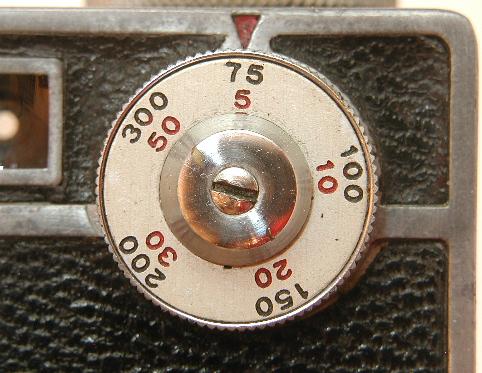

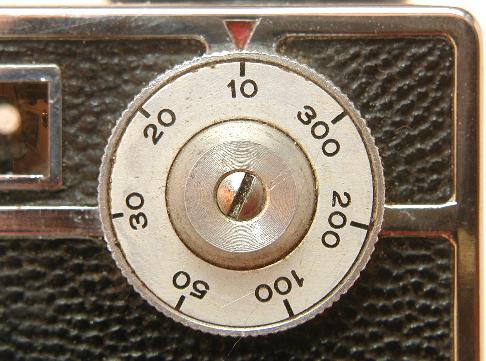
Copyright 1998-2025 by Phillip G. Sterritt
email Phillip G. SterrittLast updated 6/10/2025.
The following is a 'living document' of observations about Argus C series cameras (C / C-2 / C-3 / Match-Matic) and their attributes. I would hope that those reading this would check these against any cameras they own and report any discrepancies, fill in the holes, etc. I can be contacted via the link above for questions or comments.
The easiest way to enter information for a reasonable number of cameras is the online survey, originally created by Bob and Jeff Kelly, on the 'C Series Survey' link on this site.
We have over 7,800 cameras in the database now, largely due to the steady flow of information from the website survey. Organized by serial number, the cameras have exhibited generally consistent patterns in the progression of various features, as reflected in the following summary of 'feature milestones'.



All model Cs were made with 10 marked shutter speeds, ranging from 1/5 to 1/300 second. The first Cs had a two-range shutter speed dial with a 'F-S' (fast/slow) switch below the shutter cocking lever to choose the range and two concentric ranges of speeds (five fast, five slow) on the shutter speed dial. The design was reportedly troublesome and was changed early in the line to one with all 10 speeds in a single ring and no 'F-S' switch.
A memo from IRC to its dealers from early 1938 states that the first batch of 1,000 model Cs were shipped to dealers 'to get the dealer reaction', asking the dealers not to sell them. The memo lists the new shutter design as being incorporated into 'further regular production'. Survey data suggest that between 1,500 and 2,000 cameras with the 'F-S' switch were made. In any case, they are quite difficult to find.
The first C-2s and C-3s had the same 10 marked speeds as the later model C. Both were subsequently changed to have 7 marked speeds from 1/10 through 1/300 second.
Serial numbers themselves 'evolved' in this period. Model Cs always had their serial numbers on a paper label glued inside under the film sprockets. Both the C-2 and C-3 had two 'types' of serial number and probably switched 'types' at the same time. The first type of C-2 serial numbers continue the design and follow sequentially the range of C serial numbers.
For C-2s the serial number types are:

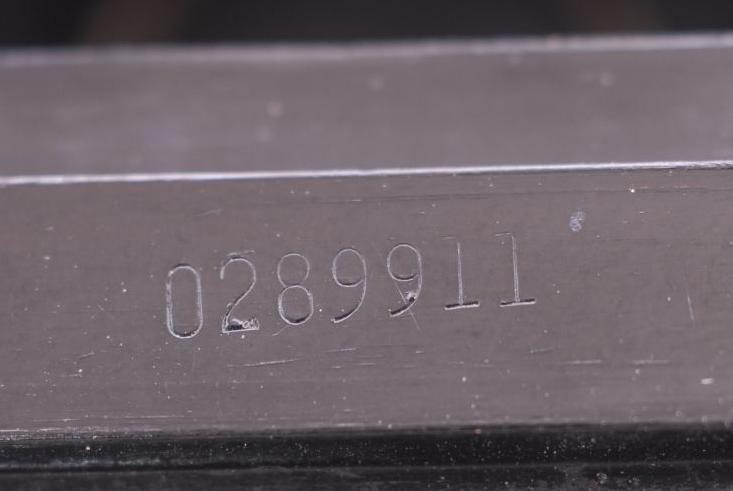
For C-3s the serial number types are:


For both cameras, the ranges expressed by the significant digits of the 'type 1' numbers observed are lower than the ranges of 'type 2' numbers observed.
Over the years, several sources have published ranges of serial numbers for various models of Argus cameras, including these for the prewar C series cameras:
| Model | Begin | End |
|---|---|---|
| C | 1001 | 19077 |
| C-2 | 19078 | 91945 |
| C-3 | 0310001 | 03690326 |
Survey data generally support the ranges for the C and C-2, as well as the starting point for C-3s. However, no prewar C-3 has been reported yet as having a number anywhere near '03690326'. The relatively modest size and production facilities of the company between 1939 and 1942 preclude their having produced enough cameras to account for a serial number this high. '03690326' is probably a typo, possibly intended to be '0390326'.
There are 3 combinations of apertures and lens labeling seen among the C-2s. Chronologically, they are:
| Apertures | Lens Labeling | |
|---|---|---|
| 3.5, 4.5, 6.3, 11, 18 | f3.5 Argus 50mm |

|
| 3.5, 4.5, 6.3, 11, 18 | f3.5 - 50mm Argus Cintar |

|
| 3.5, 4.5, 6.3, 9, 12.7, 18 | f3.5 - 50mm Argus Cintar |
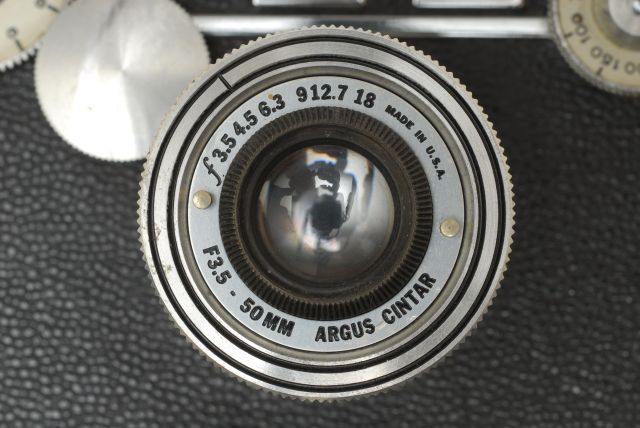
|
Only a few of the earliest prewar C-3s have been seen with the second combination and the rest have the third combination.

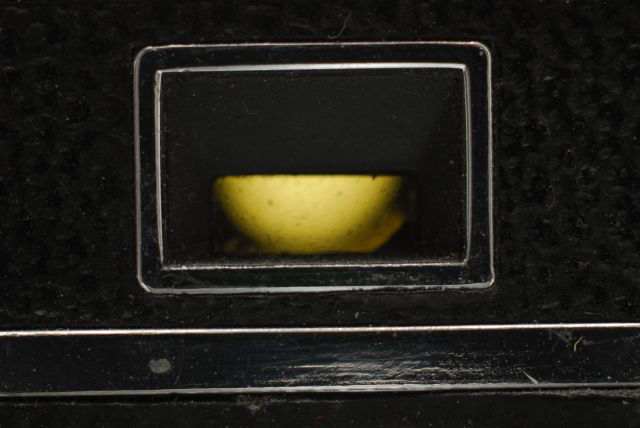
The Cs originally had rangefinders with no colored window and no lens in the viewing end of the rangefinder window. Later, the bottom rangefinder window had a blue filter added to make its image distinct from the top one. This change may have occurred with the introduction of the C-2 -- almost all C-2s and C-3s reported have colored windows and very few Cs have them. Some Cs, C-2s and C-3s that would be expected to have no tint or a blue colored window, have blue or yellow colored windows. It is likely that Argus added the filters to cameras sent in for rangefinder repair.
A flat lens was also added to the viewing end of the rangefinder window in the prewar period, though this feature is not currently covered in the survey. Another feature not covered is the addition of a small port on the top, with a silver cover with two small holes, to allow rangefinder adjustment without removing the rangefinder. This feature was added pretty early in C series production and cameras without the ports are quite scarce. In fact, many early cameras had their rangefinder assemblies replaced with new ones incorporating the port.
Mike Reitsma noted that the latest prewar C-2s and C-3s are slightly heavier and have just about all exposed metal surfaces heavily chrome-plated. This may be due to the replacement of aluminum in the body parts with another metal, as aluminum became a strategic metal with the onset of WWII.
(Top of page)
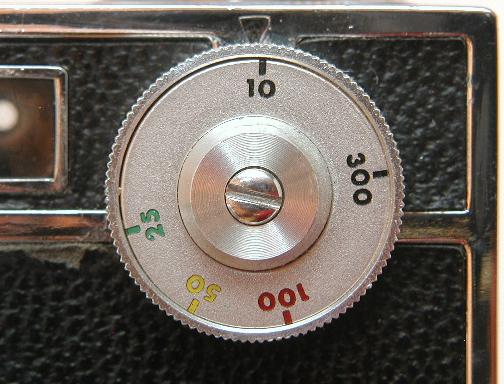

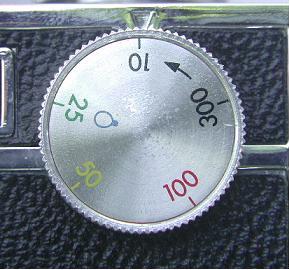
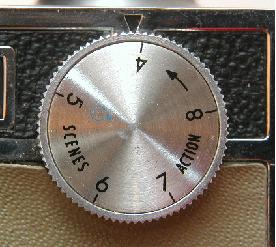
It appears that the postwar C-3s' features changed gradually, and one at a time for the most part.
The colored rangefinder window changed from a blue tint to a yellow tint. There are instances of cameras in the database with yellow rangefinders before the 'earliest' shown below. It seems possible that with the high reported number of C-3s that required rangefinder adjustment, that Argus may have chosen to replace old blue windows with yellow ones at the time of repair. A survey participant who bought his C-3 in 1950 and returned it for rangefinder repair within a year or so of purchase, stated that his blue window was replaced by a yellow one. Other colors (orange, green, etc) are occasionally reported.
The biggest 'makeover' before the introduction of the Standard C-3 occurred in the mid-900,000 serial number range (possibly in 1954) when they went to 5 shutter speeds (and the 'Colormatic' settings), removed the film reminder dial from the back, added a cassette stabilizer spring inside the back door and changed the flash synch to allow X-synch for electronic flash -- although these changes didn't occur all at once.
Charles Spickard noted another change that occurred somewhat later. The rangefinder had optics added so that the image is magnified approximately one and one-half times -- prior to this the image was lifesize.
(Top of page)To date, we know of no official production figures from Argus. One Match-Matic advertisement from 1958 states that "over two million" C-3s had been made, while another ad from August 1961 claims 2-1/2 million by that date. Survey data suggest that those numbers are inflated, even if Cs and C-2s are included. There are now enough cameras in the survey database to make some reasonable guesses as to quantities of cameras produced, at least for the more common models.
For all models except the Standard C-3 and Match-Matic, serial numbers appear to progress in an orderly chronological fashion (except for a gap in postwar cameras -- see Anomalies -- estimate adjusted for this gap). Therefore, estimates are based on ranges of serial numbers reported.
Estimates for the Standard C-3 and Match-Matic are presented with more confidence than before. With more data in the database, the two methods of estimation have given results that are much closer to each other. Two methods were used to estimate production. One is based on the number of these cameras reported compared to the number of postwar, pre-Standard C-3 cameras reported and the assumption that a Match-Matic or Standard C-3 is just as likely to be reported (in proportion to their relative numbers) as a postwar, pre-Standard C-3. The other is based on analysis of the sequential portion of the serial number within years and quarters.
| C (including 'F-S' switch model) | ~18,000 |
| C-2 | ~72,000 |
| C-3, 1939-1942 | ~80,000 |
| C-3, 1945-1957 | ~1,630,000 |
| Standard C-3 | ~129,000 |
| Match-Matic C-3 | ~301,000 |
| Golden Shield Match-Matic C-3 | ~2,500 |
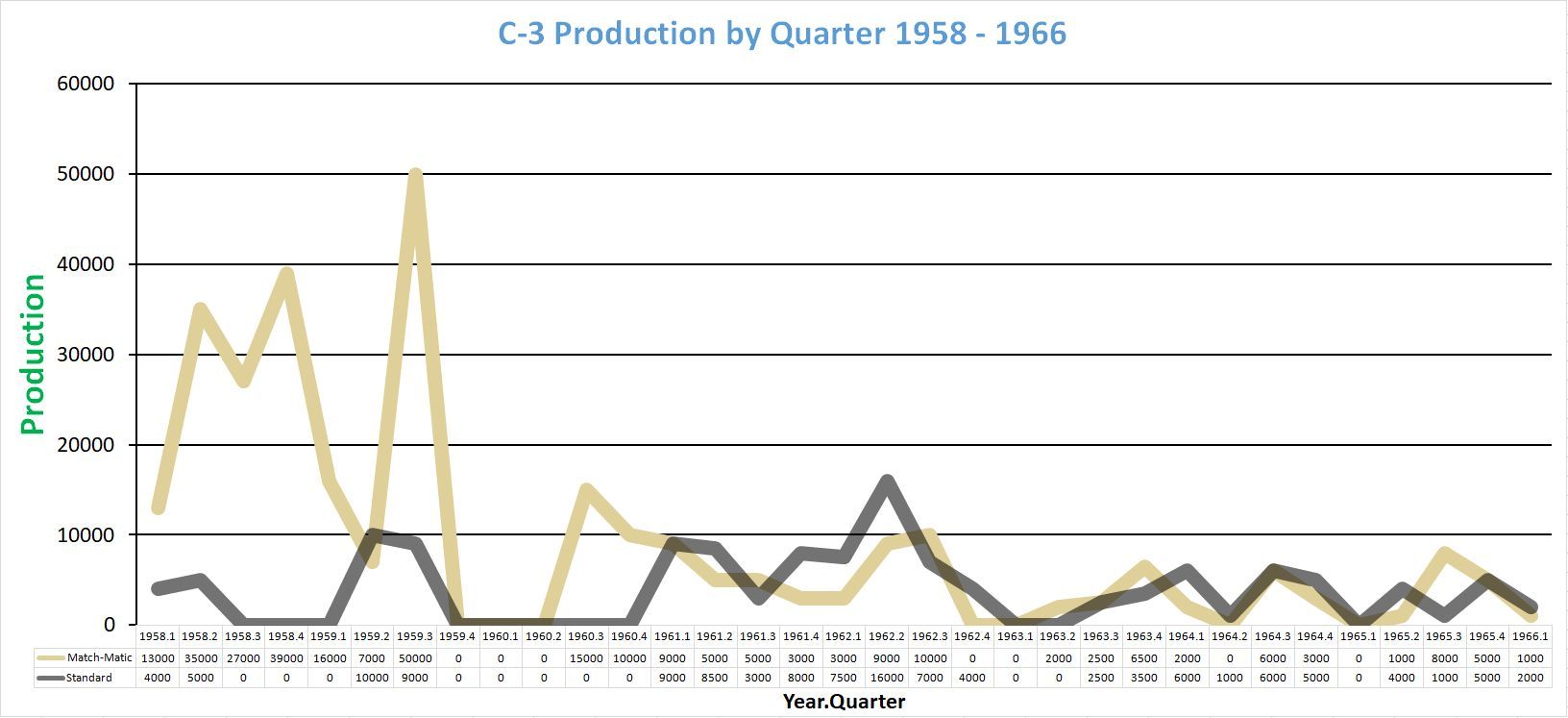
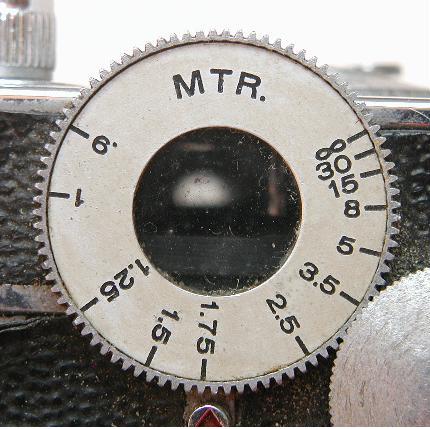
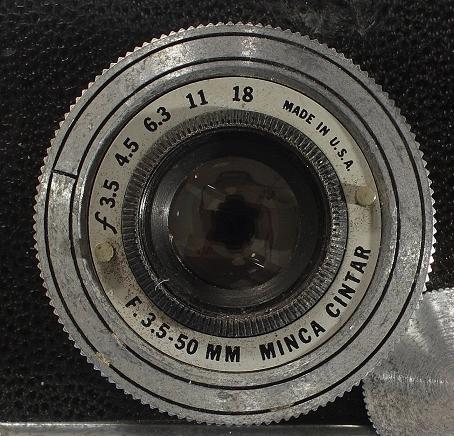
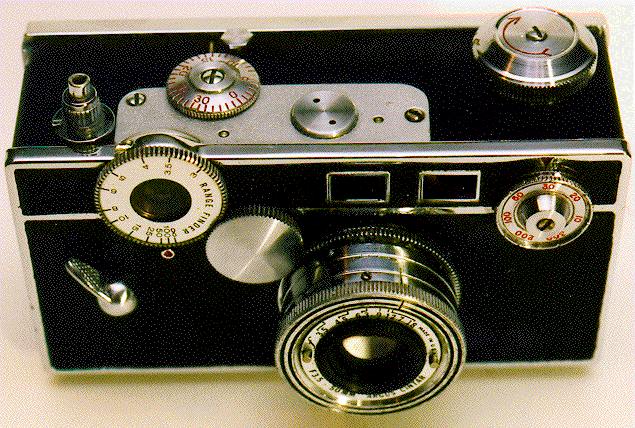
These cameras in all other respects resemble other cameras of their era.
Uncommon cameras in the C series include:

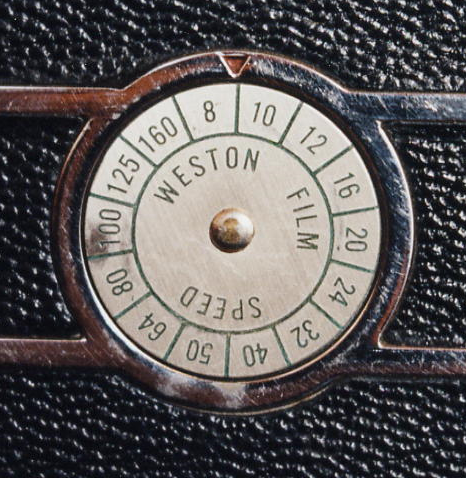
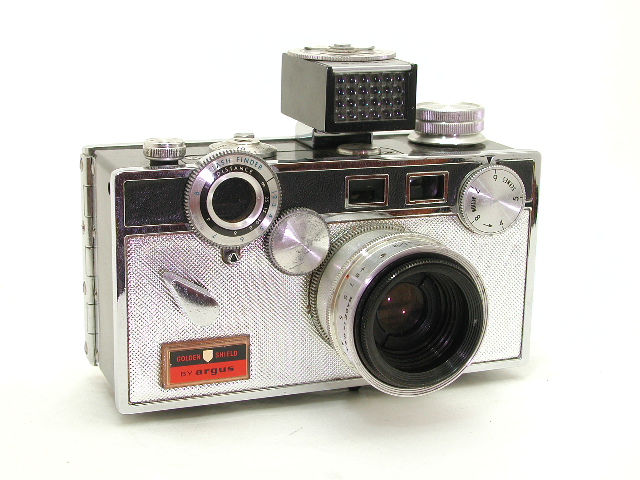
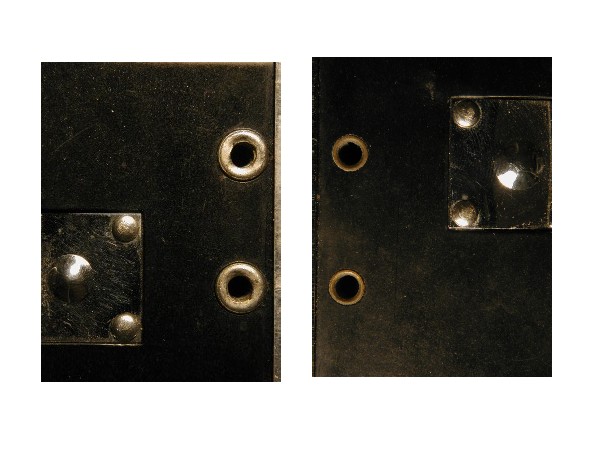
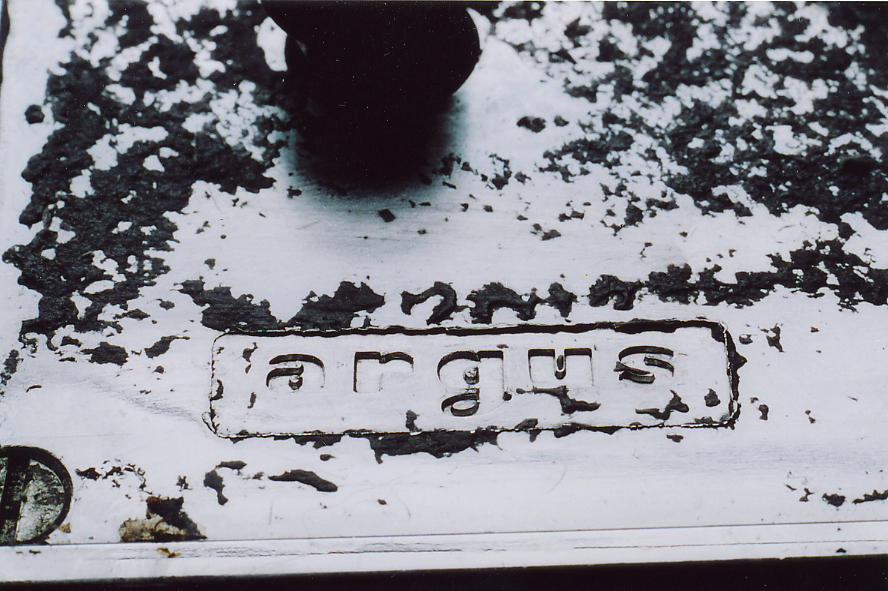


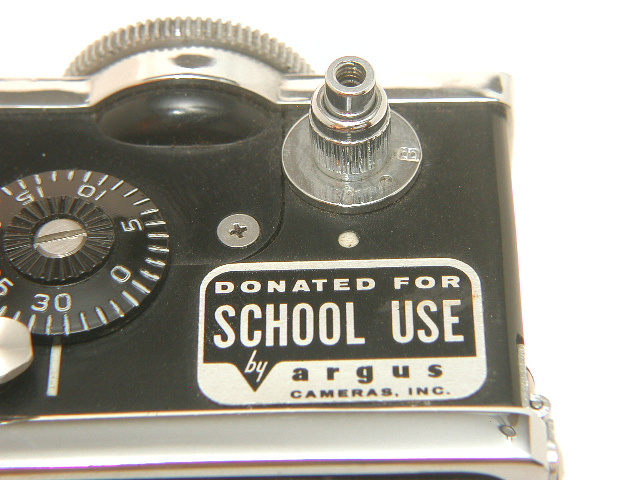
No other combination of known features appears to be particularly rare in the C series cameras.
(Top of page)Among the earliest postwar cameras, odd combinations of lens labeling and aperture ranges are seen in small batches, as noted in Lens Labeling.
After the early anomalies, the postwar/pre-Standard C-3 serial numbers generally progress in an orderly chronological fashion, with a pretty even distribution across the range. However, there is currently one large gap: No cameras are found in the survey with serial numbers between 1215383 and 1327528. There are enough cameras in the survey to state with high statistical confidence that a gap roughly this size really exists and is not just an issue of a small sample size.
An undated Argus parts price list sheet notes that two models of "Rangefinder Cap" and "Rear Rangefinder Window" are available, one each of which are "for cameras prior to serial #1314000".
Two cameras have been reported with serial numbers ending in 'T'. The numbers are 629nnnT and 808nnnT. Given the numeric portion of their serial number, both would be expected to be found with 7-speed shutters and no accessory shoe. Both are reported to have 5 speed shutters and later-model accessory shoes. They may have been cameras that were refurbished at the factory and given the latest features. Known examples of Argus model 21s that had their wind mechanism updated have an 'S' suffix and many Autronics, a model with known shutter issues during its lifetime, have 'A' or 'T' prefixes.
(Top of page)
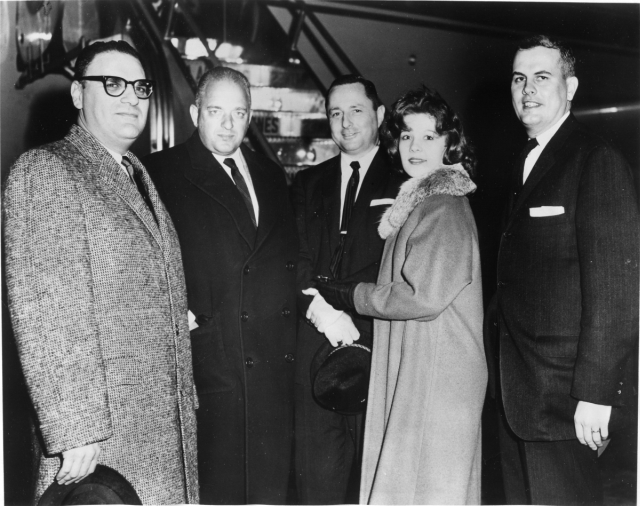
The Golden Shield Match-Matic, left, was apparently produced for the Golden Shield Corporation of Great Neck, New York. When the Golden Shield Match-Matic was produced, Sylvania owned both Argus and a majority share of Golden Shield Corp. This company bought products made by other companies, badged them with their name and sold them through jewelry stores and other retail outlets. Other than cosmetics, there is no known difference between the Golden Shield Match-Matics and ordinary Match-Matics. Right, the principals of the Golden Shield Corporation are shown in New Orleans, being welcomed by Miss New Orleans (identified only as 'Miss Greco'), at the opening of a new distribution center. From left, W. W. Israel, Vice President and Comptroller; Arthur P. Gould, President; Norman Gladney, Vice President and General Sales Manager; and H. Bruce Morrison, Sylvania District Sales Manager.
Thanks to E. Thomas Kraycirik for research that uncovered the story of the Golden Shield.
There are now 92 "Golden Shield" Match-Matics in the database. Their serial numbers all have one of the following patterns:
so if a "Golden Shield" is offered for sale where you can't see it, you may want to ask about the serial number -- if it looks like any of these, it may improve your confidence that you're not chasing another ordinary Match-Matic. NOTE: Ranges of lowest five digits of serial numbers of regular Match-Matics produced in last two quarters of 1960 (first five digits 18203 and 18204) overlap with those for Golden Shields of the period, so when verifying Golden Shields, make sure the first five digits are 18203. This overlap doesn't appear to occur with the 1961 cameras (18213 group).
Serial numbers for known Golden Shields show that Golden Shields were made in the third quarters of 1960 and 1961. (The third quarter was when products were made for holiday season sales.) The overall ranges suggest approximately 2,000 cameras made in 1960 and approximately 500 in 1961.
If you have any examples of advertising showing the Golden Shield Match-Matic when new, please email me.
(Top of page)Excerpts from "Argus Technical Service Bulletin No. 10-12 June 1, 1961":
"In the past we have maintained a stock of replacement bodies for all early model C-3 cameras. Our supply is now permanently depleted and we are substituting the Part No. 14869 Body Assembly used for the current model Match-Matic and Standard C-3.
"With the addition of the parts listed below, this body can be used on C-3 cameras with serial number 10001 through 1740000. A special hinge with 4 holes on one half to fit the 14869 body assembly and 5 holes on the other will permit you to use the 5 hole back cover from very early models.
"C-3 cameras with serial numbers lower than 64843 that have not already been converted to the 14905 Gear Train and 14860 Shutter will require a complete updating. The 14869 Body Assembly will not accept the early style gear train."
(Top of page)| Model C | |
|---|---|
| Feature | Serial Number |
| Earliest with 'F-S' switch | 1029C |
| Latest with 'F-S' switch | 2741C |
| Latest | 19041C |
-- 32156C was reported from a reliable source as having the features of a Model C. One anecdote suggests that Argus (or others) would remove the idler gear from C-2s or C-3s upon request for people who didn't like the coupled focusing, so this camera is most likely a modified C-2.
| Model C2 | ||
|---|---|---|
| Feature | Serial Number | Example |
| Earliest 'type 1' serial number | 18608C |

|
| Latest 'type 1' serial number | 62258C |

|
| Earliest 'type 2' serial number -- '00' prefix | 00 62336 |

|
| Earliest 'type 2' serial number -- '02' prefix | 02 62388 |

|
| Latest 'type 2' serial number | 02 90742 |

|
There are now 19 C-2s in the database, all having generally similar features, with serial numbers with '00' prefixes and values between 0082104 and 0084108. Another example, 0062336, fits into the current gap between the 'type 1' and 'type 2' serial numbers.
| Model C3 | ||
|---|---|---|
| Feature | Serial Number | Example |
| Earliest 'type 1' serial number | C3 10003 |

|
| Latest 'type 1' serial number | C3 23678 |

|
| Earliest 'type 2' serial number | 03 23848 |

|
| Latest 'type 2' serial number | 03 90242 |

|
(See notes about Prewar Cameras above)
The first cameras made when civilian production resumed in 1945 started with 0nnnn and proceeded upward from there to 1740000 in 1957. However, it appears that the first several thousand cameras that would have started from 100000 had the leading '1' omitted from the serial number, so they appear as a five-digit number between 00000 and around 12000.
Cameras with a five-digit serial number between 00000 and 12000 with the following set of features are accurately numbered and were probably made in 1945 or early 1946:


Cameras with a five-digit serial number between 00000 and 12000 with the following set of features are missing the leading '1' in their serial numbers (add 100000 to get the correct number) and were probably made in late 1946 or early 1947:
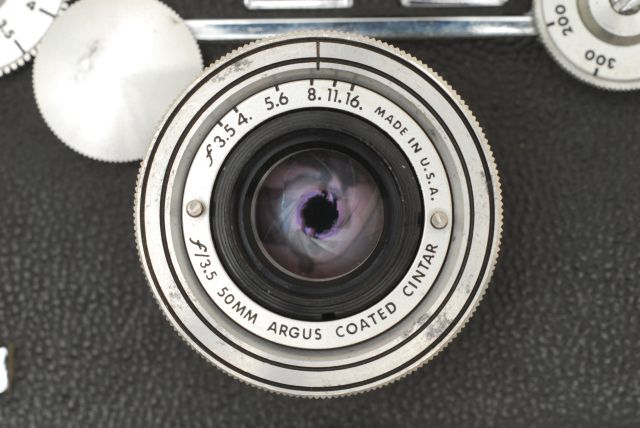

Thus, the earliest camera listed below is the lowest currently known serial number on a camera with features consistent with a valid five-digit serial number, as noted above.
Thanks to Curtis Riddick for information that helped solve the riddle of the earliest postwar cameras.
| C-3 - Postwar, Pre-Standard (1945-1957) | |
|---|---|
| Feature | Serial Number |
| Earliest | 01847 |
| latest stamped inside rightside up | 787578 |
| earliest stamped inside upside down | 788400 |
| Latest | 1737375 |
An article in the Michigan Photographic Historical Society's publication, "The Photogram", apparently dating from the late 1970s, cites a local source (probably Don Wallace or Milt Campbell) on the subject of Argus serial numbers of the period. It states that from 1958 on, Argus cameras with ten-digit serial numbers (including all C-3s of the period) have a common coding pattern. The first three digits of the serial number are the model of the camera (182 for Match-Matics, 192 for Standards), the next two digits represent the year quarter and year and the final five digits are the "unique" portion of the serial number.
Published information states that serial numbers for Match-Matics start from 1821800001. Analysis of the data suggests that the earliest cameras follow this pattern as the Photogram article suggests. Thus, the earliest Match-Matics have serial numbers beginning with 18218... and 18228..., and the earliest Standard C-3s have 19218..., but these are the only cameras of this period that conform to this pattern.
But survey data, and patterns observed in other Argus cameras of the same period, support the fourth digit being the year and the fifth being the year quarter. From the second quarter of 1958 on, Standard C-3s amd Match-Matics follow this format. Observed fourth digits range from 8 (1958) through 6 (1966). None have been seen so far with a fourth digit of '7'. Fifth digits are overwhelmingly between one and four. The 'unique' portions of the serial number generally move upward as expected as the years and quarters change.
Anomalies do exist in the database, but in small 'batches' that suggest temporary deviations in the serial number coding standard. These kinds of anomalies are seen in ranges of C-3s of prior years as well as in other models. Argus' repair service would convert Match-Matics to Standards and vice versa for a nominal fee, so that could explain instances of cross-model numbers.
| Standard C-3s and Match-Matics (1958-1966) | |
|---|---|
| Feature | Serial Number |
| Earliest Standard C-3 | 1921800692 |
| Latest Standard C-3 | 1926175615 |
| Earliest Match-Matic | 1821800056 |
| Latest Match-Matic | 1826175114 |
-- a few Match-Matics reported starting with '282...', '192...', '184...' and '162...'. 1826476520 was also reported, but is a distinct outlier as it seems unlikely that they produced any Match-matics or Standards as late as the fourth quarter of 1966.
Survey data show that about twice as many Match-Matics as Standard C-3s were produced. (See notes about Estimated Production Figures above)
| Golden Shield Match-Matics | |
|---|---|
| Feature | Serial Number |
| Lowest "Golden Shield", Range 1 | 1820372503 |
| Highest "Golden Shield", Range 1 | 1820374361 |
| Lowest "Golden Shield", Range 2 | 1821374392 |
| Highest "Golden Shield", Range 2 | 1821374886 |
(See "The Golden Shield" above)
(Top of page)| C-2 | ||
|---|---|---|
| Feature | Serial Number | Example |
| Latest 10 Shutter Speeds | 02 70838 |

|
| Earliest 7 Shutter Speeds | 02 70902 |

|
| C-3 (prewar) | ||
|---|---|---|
| Feature | Serial Number | Example |
| Latest 10 Shutter Speeds | 03 41907 |

|
| Earliest 7 Shutter Speeds | 03 42138 |

|
| C-3 (postwar) | ||
|---|---|---|
| Feature | Serial Number | Example |
| Latest 7 Shutter Speeds | 964476 |

|
| Earliest 5 shutter speeds (uneven spacing) | 965240 |

|
| Latest 5 shutter speeds (uneven spacing) | 1058973 |

|
| Earliest 5 shutter speeds (even spacing) | 1059490 |

|
An undated memo from the Argus Customer Service Department states that 'All Argus C3 cameras with serial numbers higher than 964482 are factory-synchronized for X-or-Zero-Delay electronic flash units having flash durations longer than 1/750 second.' This may be the point at which the first cameras with 5 marked shutter speeds appeared.
(Top of page)| C-2 | ||
|---|---|---|
| Feature | Serial Number | Example |
| Latest 3.5, 4.5, 6.3, 11, 18 | 54724C |

|
| Earliest 3.5, 4.5, 6.3, 9, 12.7, 18 | 54448C |

|
| C-3 (prewar) | ||
|---|---|---|
| Feature | Serial Number | Example |
| Latest 3.5, 4.5, 6.3, 11, 18 | C3 14883 |

|
| Earliest 3.5, 4.5, 6.3, 9, 12.7, 18 | C3 14334 |

|
C-3 (postwar): This is a very mixed bag in the first 100,000 or so cameras produced after the end of World War II. They start out with the prewar numbers (3.5, 4.5, 6.3, 9, 12.7, 18) but mixed in with these are cameras with the scale they settled in with around 1947 (3.5, 4, 5.6, 8, 11, 16). This was probably a result of only being able to get small batches of parts at a time due to postwar shortages. See notes about Lens Labeling below.
| C-3 (postwar) | ||
|---|---|---|
| Feature | Serial Number | Example |
| Latest 3.5, 4.5, 6.3, 9, 12.7, 18 | 75716 |

|
| Earliest 3.5, 4, 5.6, 8, 11, 16 | 41471 |
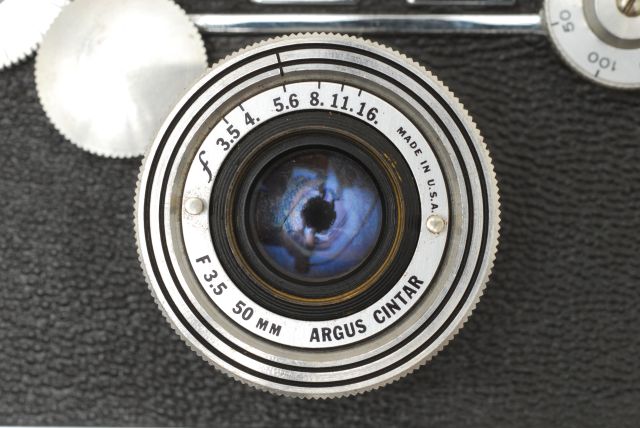
|
There are a couple of groups of outliers after 75716 with aperture scale 3.5, 4.5, 6.3, 9, 12.7, 18, with all other features as expected -- one group in the early 90000s and one in the early 150000s.
Match-Matics: 3.5, 4, 5, 6, 7, 8
| C-2 | ||
|---|---|---|
| Feature | Serial Number | Example |
| Latest "f/3.5 Argus 50mm" | 41320C |

|
| Earliest "f/3.5 - 50mm Argus Cintar" | 40825C |

|
-- (overlap noted)
C-3
Prewar C-3s: "f/3.5 - 50mm Argus Cintar".
Postwar C-3s:
Labeling is really mixed for the first cameras produced after WWII, possibly due to material shortages causing only small quantities of parts to be produced. Combinations of labeling and apertures through roughly 75000 include:
| Lens label | Apertures | coated/uncoated | Example |
|---|---|---|---|
| "f/3.5 - 50mm Argus Cintar" | 3.5, 4.5, 6.3, 9, 12.7, 18 | uncoated |

|
| "f/3.5 - 50mm Argus Cintar" | 3.5, 4.5, 6.3, 9, 12.7, 18 | coated |

|
| "f/3.5 - 50mm Argus Cintar" | 3.5, 4, 5.6, 8, 11, 16 | coated |

|
| "f/3.5 - 50mm Argus Coated Cintar" | 3.5, 4.5, 6.3, 9, 12.7, 18 | coated |

|
| "f/3.5 - 50mm Argus Coated Cintar" | 3.5, 4, 5.6, 8, 11, 16 | coated |

|
pre - Standard C-3s from roughly 75000 on: "f3.5 - 50mm Argus Coated Cintar"
Standard C-3s and Match-Matics: "Argus 50mm f3.5 Coated Cintar"
| C-2 | ||
|---|---|---|
| Feature | Serial Number | Example |
| Latest with 3 leatherette strips | 00 62336 |

|
| Earliest Weston filmspeed reminder dial | 02 62388 |

|
This feature seems to occur at almost the same time as the change in serial number 'type' in the C-2, but not the C-3. 62258C is the latest 'Type 1' serial number with three strips; 0062336 also has 3 strips, to add to its distinction as a '00' prefix C2 serial number.
| C-3 (prewar) | ||
|---|---|---|
| Feature | Serial Number | Example |
| Latest with 3 leatherette strips | 03 25082 |

|
| Earliest Weston filmspeed reminder Dial | 03 25331 |

|
| C-3 (postwar) | ||
|---|---|---|
| Feature | Serial Number | Example |
| Latest Weston filmspeed reminder Dial | 256876 |

|
| Earliest ASA filmspeed reminder dial | 257056 |
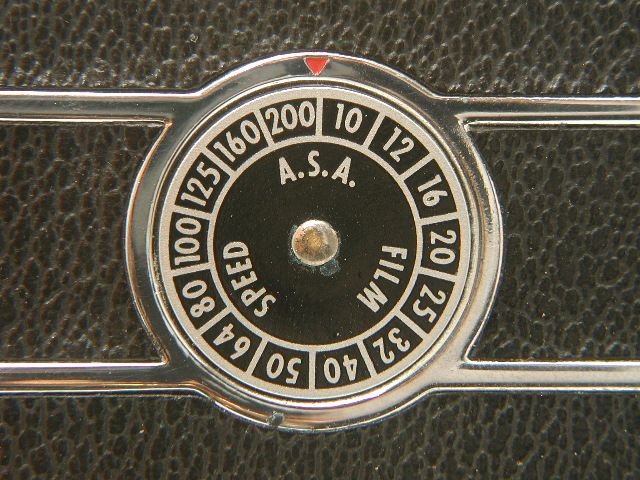
|
| Latest ASA filmspeed reminder dial | 937605 |

|
| Earliest no dial/3 strips | 932583 |

|
| Latest no dial/3 strips | 1660498 |

|
| Earliest solid leatherette back | 1650806 |
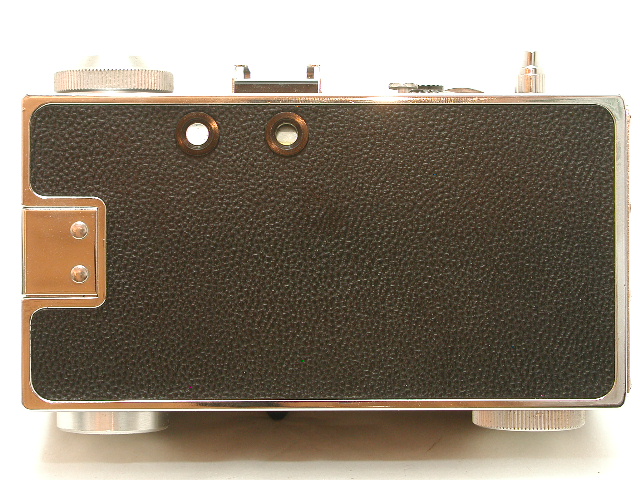
|
-- some contiguous examples between 9363xx and 9374xx reported with ASA filmspeed reminder dial. All cameras (currently) starting at 937669 have no dials.
-- numerous examples between 1603xxx and 1654xxx reported with solid backs.
-- See Rarities above for an example of the uncommon 'champagne'-color Weston dial.
Mold Marks are small marks molded into the plastic body casing, underneath the sprocket wheels, by the outside company that manufactured them for Argus. Most companies that made molded plastic products came up with their own distinctive mold marks, which were recorded in industry publications such as the Modern Plastics Encyclopedia.
Over the history of the C series cameras, at least three companies made these body casings, and each had its own distinctive mold mark:
| Company | Mold Mark | Years (approximate) |
|---|---|---|
| Reynolds Molded Plastics of Jackson, Michigan ('RMP') |
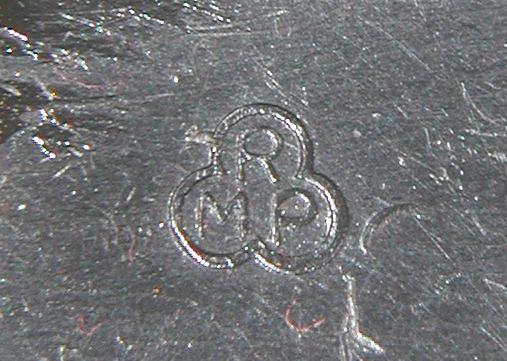
|
1938 - 1940 |
| Peerless Plastics of Toledo, Ohio ('P in Shield') |

|
1940 - 1947 |
| Modern Plastics Corporation of Benton Harbor, Michigan ('Small MPC') |
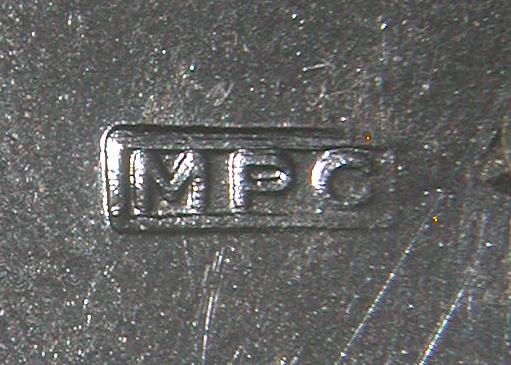
|
1947 - 1954 |
| Modern Plastics Corporation of Benton Harbor, Michigan ('Large MPC') |

|
1954 on |
A fourth company, Michigan Molded Plastics of Dexter, Michigan may also have made C series bodies for Argus in the prewar period. One advertisement from 1941 has been found showing C series body casings as one of their products. They, too had a distinctive mold mark -- an 'M' in a square border. No cameras have been found with that mark; however, several Cs and C2s are known to exist with no mold marks, or appear to have excised mold marks. It's pure speculation, but maybe these bodies were made by Michigan Molded Plastics.
Mold marks were a later addition to the C series survey, and when they were first added to the survey form, there were only written descriptions. That, and the difficulty people had locating the marks, made early data sporadic and less reliable. Later, pictures were added to the survey questions, and data has become more consistent. Hopefully, the endpoints as stated will improve with time.
-- All Model C cameras have either the 'RMP' mold mark or none at all.
-- All Model C2 cameras have either the 'RMP' mold mark, 'P in Shield' mold mark, or none. Some look like a mold mark was deliberately excised.
-- All Standard C3s and Match-Matic C3s have the 'Large MPC' mold mark.
| C2 | ||
|---|---|---|
| Mold Mark | Serial Number | Example |
| Latest RMP | 02 73871 |

|
| Earliest P in Shield | 02 65284 |

|
| C3 | ||
|---|---|---|
| Mold Mark | Serial Number | Example |
| Latest RMP | 03 47565 |

|
| Earliest P in Shield | 03 42237 |

|
| Latest P in Shield | 103857* |

|
| Earliest Small MPC | 104194* |

|
* These cameras have five-digit serial numbers beginning with zero, but are strongly believed to be missing the leading '1' and have 'true' serial numbers that are 6 digits and greater than 100,000.
Latest Small MPC, earliest Large MPC: this distinction has always been one of the hardest feature for survey respondents to report accurately, and understandably so. Better pictures and descriptions are improving the results, but at this point it is hard to pin down reliable endpoints for this data. For now, it looks like the change happened at around the 900000 mark.
| Feature | Serial Number | Example |
|---|---|---|
| Latest "type 1" shutter release | 47167C |
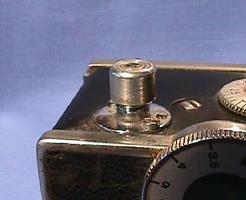
|
| Earliest "type 2" shutter release | 44832C |

|
The Kalart Confidential Dealer Price List of Sept. 1, 1946 lists a synchronizer adapter (presumably to connect to the shutter release) for Argus C and C2 cameras "with Serial No. up to 47,201". This is probably when the change from "Type 1" to "Type 2" "officially" occurred, since the "Type 2" shutter releases had a standard cable release thread that wouldn't have required an adapter. (anomalies in above figures noted; only a few examples before 47200)
| Feature | Serial Number | Example |
|---|---|---|
| Latest silver shutter cocking lever | 53997 |

|
| Earliest black shutter cocking lever | 44525 |

|
-- a whole lot of overlap on both sides of this one.
(Top of page)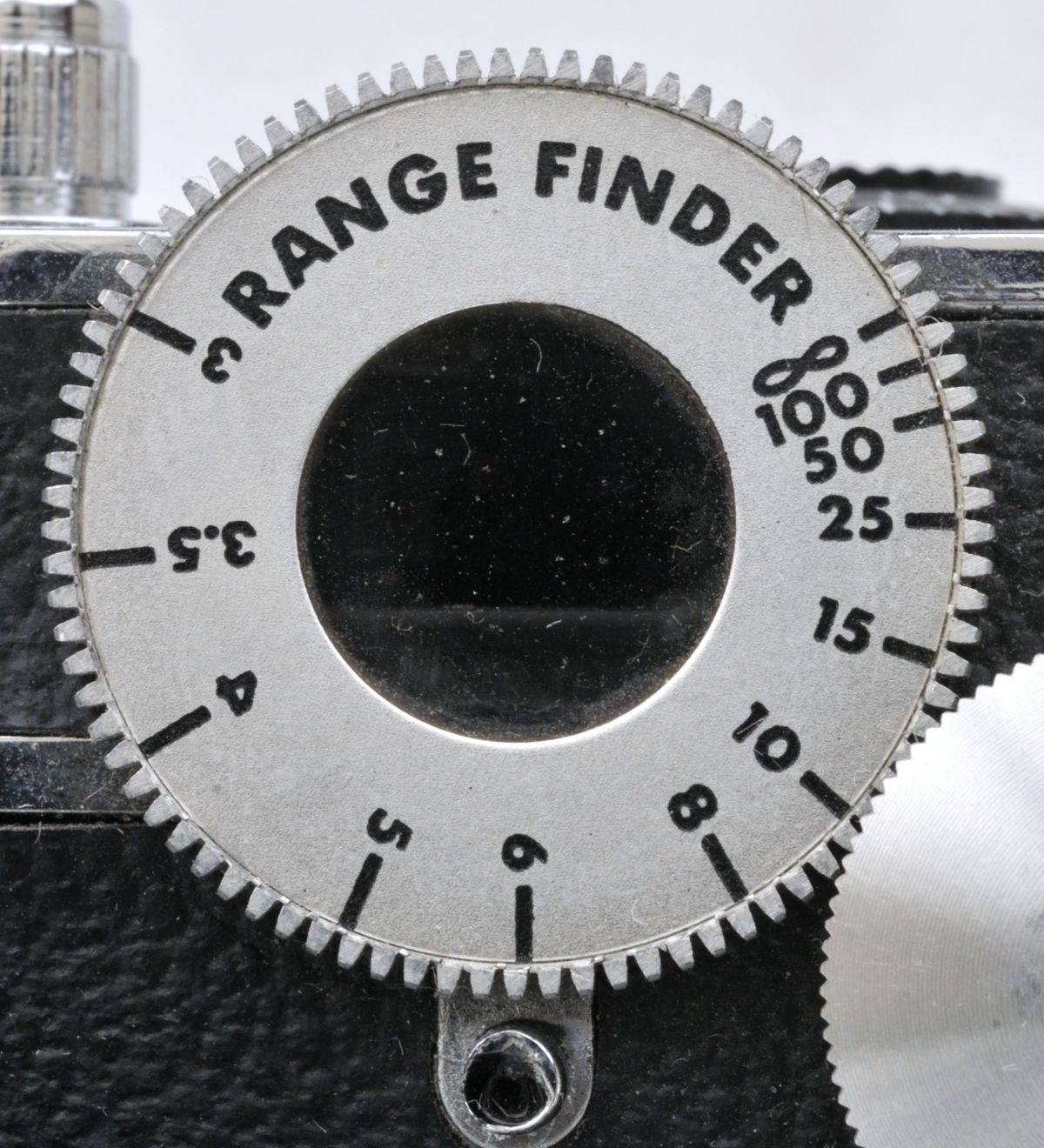
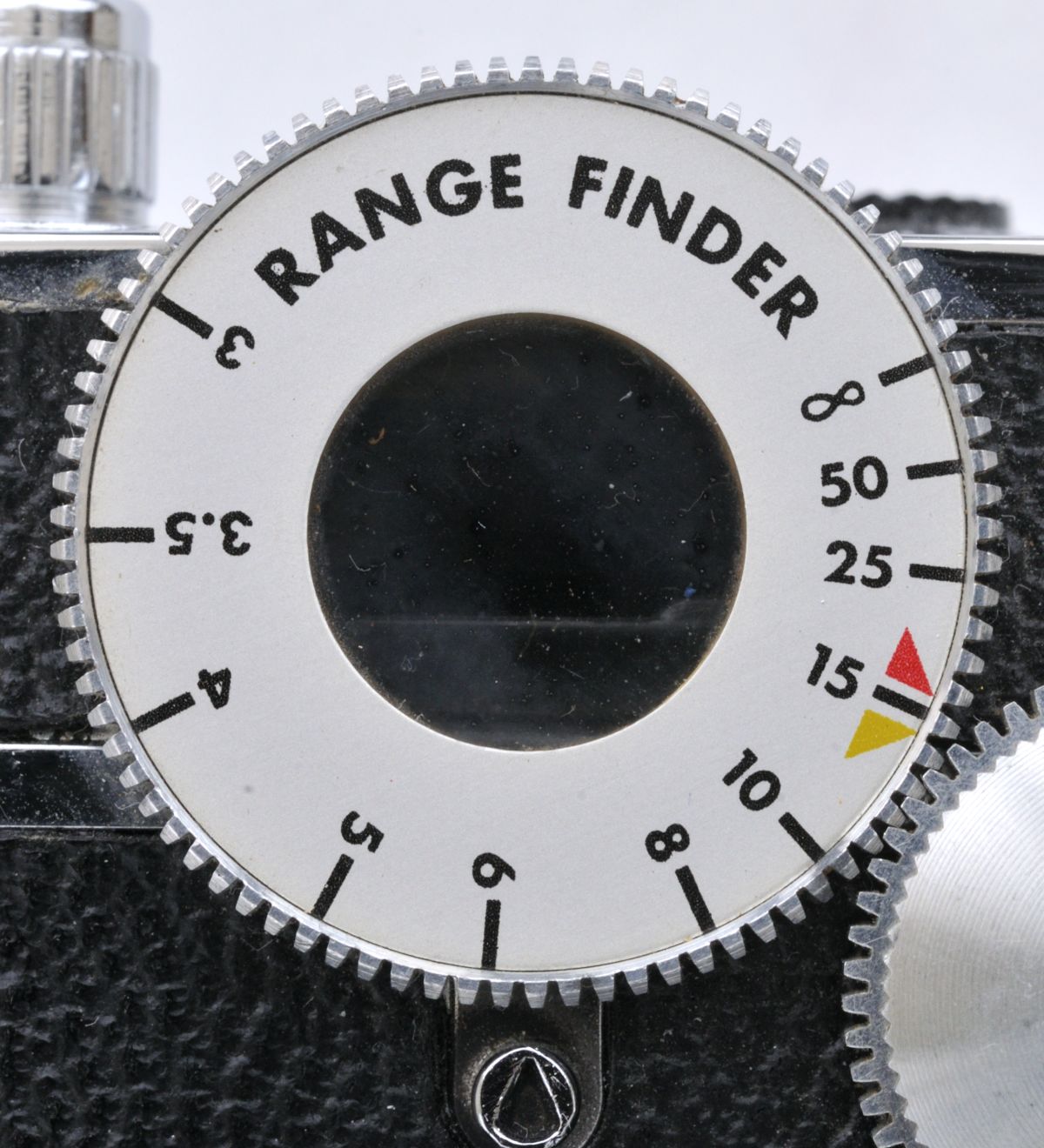

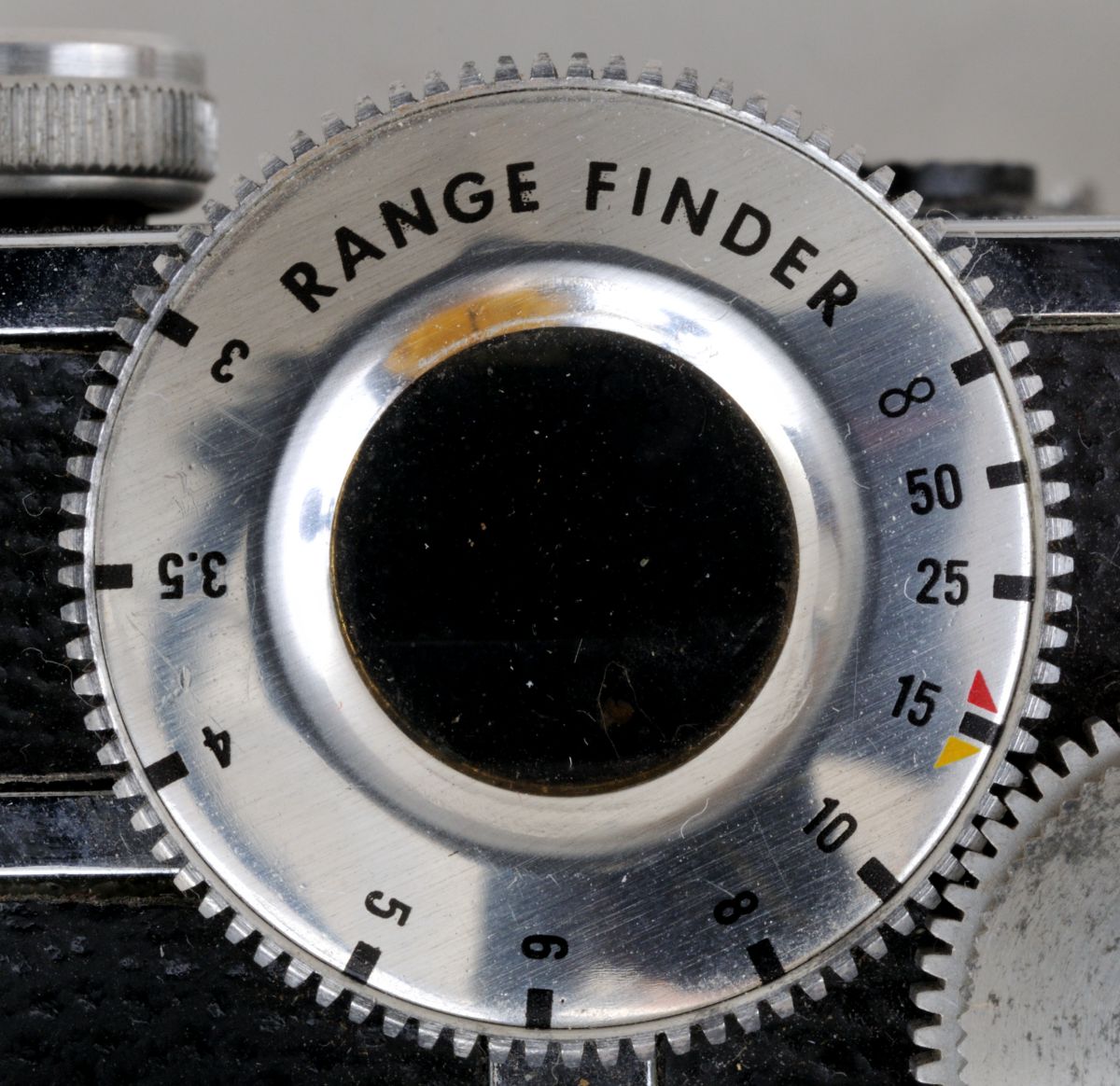

There were relatively few changes to the rangefinder scales over the history of the C series. They can be summarized as follows:
C: Scales have ranges of either 3 ft - 100 ft and infinity, or 3.5 ft - 100 ft and infinity. Scales are randomly mixed between those starting with 3 and 3.5 feet up to roughly serial number 5000C, then overwhelmingly those starting with 3.5 feet
C2: Scales have ranges of 3 ft - 100 ft and infinity. There are currently 4 examples of metric dials.
C3, prewar: Scales have ranges of 3 ft - 100 ft and infinity. There are currently 2 examples of metric dials.
C3, postwar: Scales have ranges of 3 ft - 100 ft and infinity through 1953, changing to ranges of 3 ft - 50 ft and infinity, plus Colormatic markings, in 1954.
Match-Matic C3: All have 'Flashfinder' dial, with Match-Matic aperture settings by distance.
Standard C3: All have redesigned scales of 3 ft - 50 ft and infinity dials with Colormatic settings.
(Top of page)| Feature | Serial Number | Example |
|---|---|---|
| Latest blue rangefinder | 385859 |

|
| Earliest yellow rangefinder | 386125 |

|
-- "Earliest Yellow" refers to the earliest serial number from which point all cameras in the database have yellow rangefinders, since many older cameras have yellow rangefinders that are replacements

| Feature | Serial Number |
|---|---|
| Latest without raised "argus" logo | 549001 |
| Earliest raised "argus" logo | 548749 |
-- Some cameras between 542nnn and 545nnn found with a recessed "argus" logo, in the same style and location as the later logo but flush with the metal camera faceplate and hidden under the leatherette. Others found between 546nnn and 547nnn with ground-down areas indicating some kind of logo was obliterated. It apparently took Argus a few tries to get the desired look. See Rarities above for examples.
| Feature | Serial Number | Example |
|---|---|---|
| Latest silver metal film counter | 583126 |
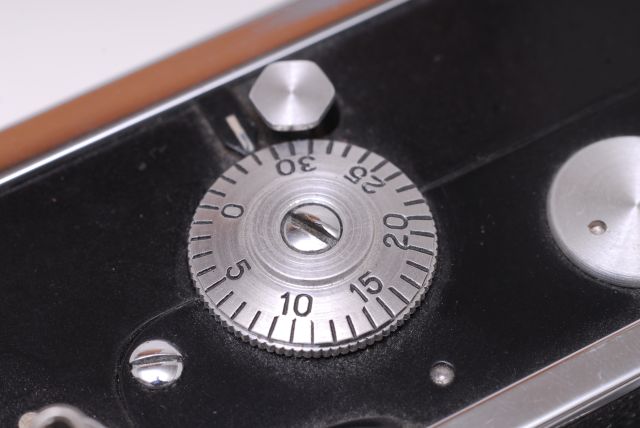
|
| Earliest black plastic film counter | 581218 |

|
(although they resumed using silver counters with Match-Matics)
| Feature | Serial Number | Example |
|---|---|---|
| Latest 10 back hinge screws | 597892 |
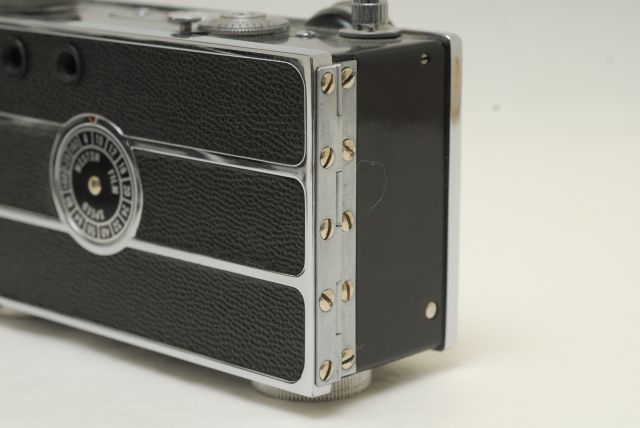
|
| Earliest 8 back hinge screws | 595950 |
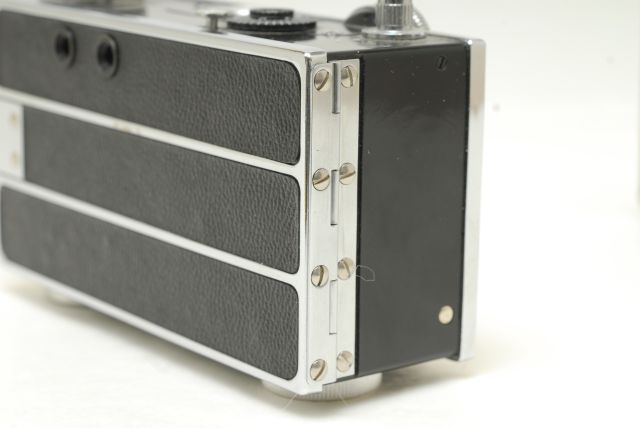
|
-- small outcroppings in the 693nnn and 872nnn-873nnn vicinities also have 10. A replacement hinge with 5 holes on one side and 4 on the other was supplied by Argus to allow older doors on newer bodies (and perhaps vice-versa).
| Feature | Serial Number | Example |
|---|---|---|
| Latest with no accessory shoe | 1340098 | |
| Earliest aluminum (3-screw) accessory shoe | 1340685 |
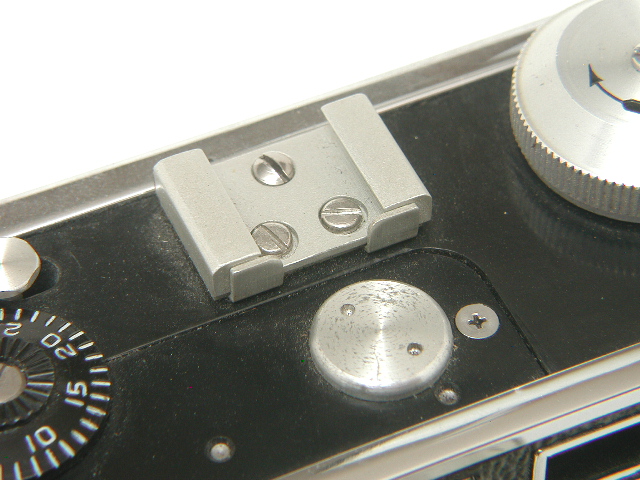
|
| Latest aluminum (3-screw) accessory shoe | 1489587 |

|
| Earliest plastic (1-screw) accesssory shoe | 1489380 |

|
-- Examples of accessory shoes occur frequently on earlier cameras; these are mostly aftermarket modifications. "Earliest" refers to the earliest serial number from which point all cameras in the database have the indicated style of accessory shoe, except for the overlap between the latest 3-screw shoe and the earliest 1-screw shoe.
(Top of page)